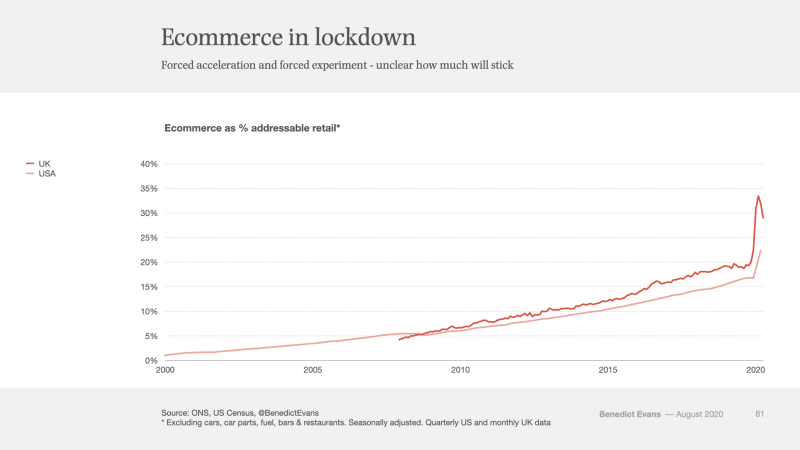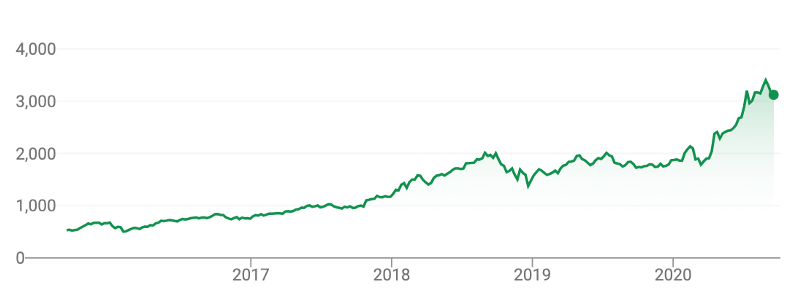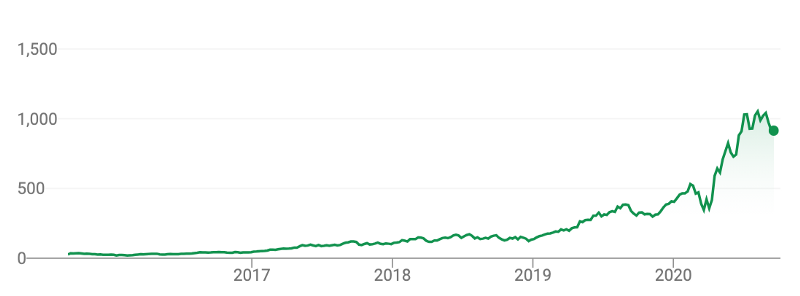From personal trainers to plumbers, the internet is finally making its way to local businesses.
E-comm is growing (duh)
I am sure you have seen some version of this graph– the pandemic has accelerated the growth of e-commerce, and even before 2020 it has been steadily rising for at least the last decade.

But when we say “e-comm” what we really mean is “e-retail” i.e. the buying and selling of stuff.
Here is Amazon’s stock price over the last 5 years. (Amazon constitutes ~37% of U.S. retail e-comm sales)

Here is Shopify’s stock price over the last 5 years. (Shopify constitutes ~6% of U.S. retail e-comm sales and powers over 1 million online stores)

TL;DR = Lots of goods being sold over the internet. Got it.
E-comm for services?
Services constitute ~80% of the U.S. GDP. (80%!) So when we are talking about commerce moving online, we are really talking about the other 20%. Referencing the first graph above, e-comm accounts for about 25% of retail, so that’s that’s ~5% of total U.S. GDP.
What about services? Services is an incredibly wide category, but the slice I am interested in are the types that are a rough analogue to what we’re seeing fuel growth on the goods side: small businesses that previously wouldn’t have been able to operate online but are now enabled by technologies like Shopify.
I am thinking about fitness trainers and nutritionists, SAT tutors and piano teachers, landscapers and electricians– local, often 1 person businesses, that today still operate almost entirely offline.
These businesses, like their retail counterparts, are finding that to compete in the 2020s, they need to get online, leveraging online discovery, social media, online payments, automated scheduling, marketing automation, contact management, etc. And like retail, this need has only been exacerbated by the pandemic. (Anyone else seeing a therapist over Zoom? ✋)
And as they join the party, we need to expand our definition of e-commerce.
Time is money

Unlike the world of goods, what these sorts of businesses are selling is their time. And there is a fixed amount of inventory i.e. the hours in the day.
Before starting MAZ, I had a business called Paul The Wizard (the website is still live for those looking to relive that sweet 2009 aesthetic) which I started after leaving Apple. I would be paid by the hour to go to people’s homes to set up their WiFi router, teach them how to use their computer, migrate their iTunes library, and so on. I spent a lot of time corresponding with customers and prospective customers about scheduling, I was paid by cash or check, and I had no way to keep track of customer information other than Gmail and my iPhone contacts.
Today, over 10 years later, not that much has changed. Maybe it’s WhatsApp instead of Gmail and Venmo instead of a check, but these sorts of 1 person service businesses still operate in an unorganized and largely offline way.
So what’s next?
Like with retail e-comm, we will see (and are already seeing) a plethora of new tools that will unlock this market. There are aggregators that will become the equivalents of Amazon and Etsy. There will be new payments solutions aimed at services. There will be new analytics solutions.
I spent the last 10 years figuring out how media businesses could establish an online presence to sell content online (digital goods) with MAZ.
Now I’m spending my time at Bounce House working on how we can become the Shopify for services: a centralized tool to sell services online, instead of selling goods.
Someone is going to crack that other other 80%…






